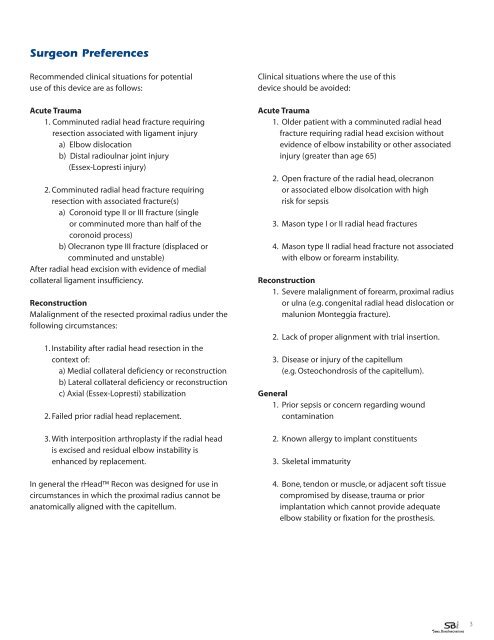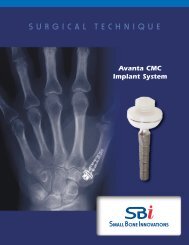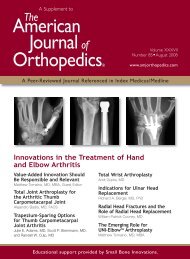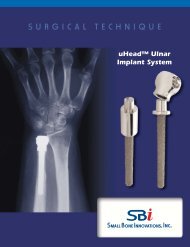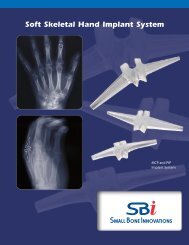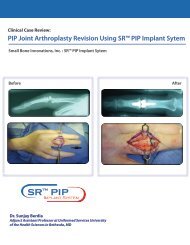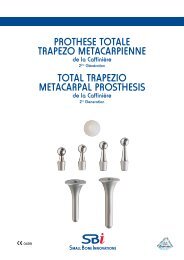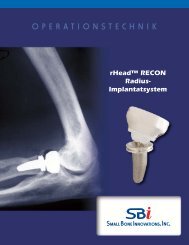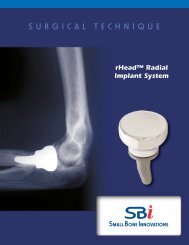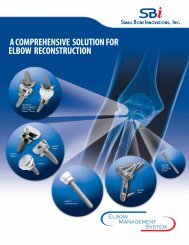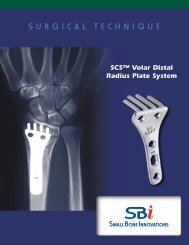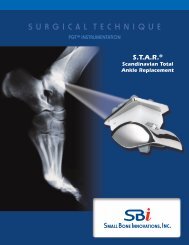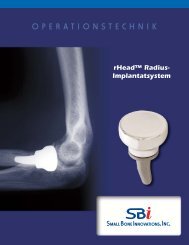Download the rHead⢠RECON Surgical Technique - Small Bone ...
Download the rHead⢠RECON Surgical Technique - Small Bone ...
Download the rHead⢠RECON Surgical Technique - Small Bone ...
You also want an ePaper? Increase the reach of your titles
YUMPU automatically turns print PDFs into web optimized ePapers that Google loves.
Surgeon Preferences<br />
Recommended clinical situations for potential<br />
use of this device are as follows:<br />
Acute Trauma<br />
1. Comminuted radial head fracture requiring<br />
resection associated with ligament injury<br />
a) Elbow dislocation<br />
b) Distal radioulnar joint injury<br />
(Essex-Lopresti injury)<br />
2. Comminuted radial head fracture requiring<br />
resection with associated fracture(s)<br />
a) Coronoid type II or III fracture (single<br />
or comminuted more than half of <strong>the</strong><br />
coronoid process)<br />
b) Olecranon type III fracture (displaced or<br />
comminuted and unstable)<br />
After radial head excision with evidence of medial<br />
collateral ligament insufficiency.<br />
Reconstruction<br />
Malalignment of <strong>the</strong> resected proximal radius under <strong>the</strong><br />
following circumstances:<br />
1. Instability after radial head resection in <strong>the</strong><br />
context of:<br />
a) Medial collateral deficiency or reconstruction<br />
b) Lateral collateral deficiency or reconstruction<br />
c) Axial (Essex-Lopresti) stabilization<br />
2. Failed prior radial head replacement.<br />
3. With interposition arthroplasty if <strong>the</strong> radial head<br />
is excised and residual elbow instability is<br />
enhanced by replacement.<br />
In general <strong>the</strong> rHead Recon was designed for use in<br />
circumstances in which <strong>the</strong> proximal radius cannot be<br />
anatomically aligned with <strong>the</strong> capitellum.<br />
Clinical situations where <strong>the</strong> use of this<br />
device should be avoided:<br />
Acute Trauma<br />
1. Older patient with a comminuted radial head<br />
fracture requiring radial head excision without<br />
evidence of elbow instability or o<strong>the</strong>r associated<br />
injury (greater than age 65)<br />
2. Open fracture of <strong>the</strong> radial head, olecranon<br />
or associated elbow disolcation with high<br />
risk for sepsis<br />
3. Mason type I or II radial head fractures<br />
4. Mason type II radial head fracture not associated<br />
with elbow or forearm instability.<br />
Reconstruction<br />
1. Severe malalignment of forearm, proximal radius<br />
or ulna (e.g. congenital radial head dislocation or<br />
malunion Monteggia fracture).<br />
2. Lack of proper alignment with trial insertion.<br />
3. Disease or injury of <strong>the</strong> capitellum<br />
(e.g. Osteochondrosis of <strong>the</strong> capitellum).<br />
General<br />
1. Prior sepsis or concern regarding wound<br />
contamination<br />
2. Known allergy to implant constituents<br />
3. Skeletal immaturity<br />
4. <strong>Bone</strong>, tendon or muscle, or adjacent soft tissue<br />
compromised by disease, trauma or prior<br />
implantation which cannot provide adequate<br />
elbow stability or fixation for <strong>the</strong> pros<strong>the</strong>sis.<br />
3


